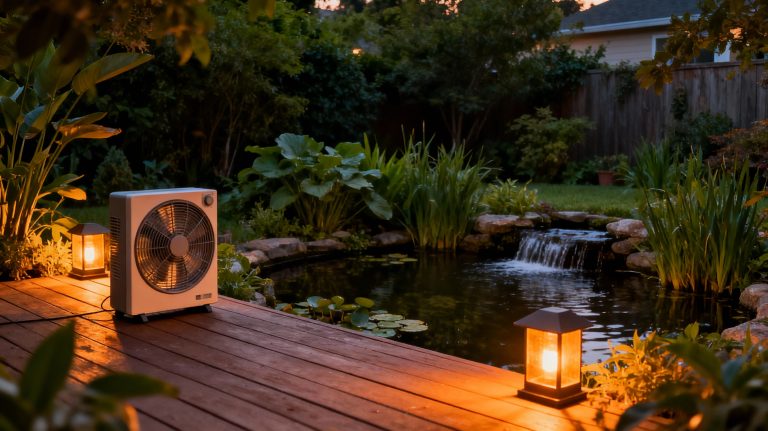Every summer, I hit the same wall: mosquitoes. The first warm night on the deck feels perfect until that high-pitched whine starts circling my ears.
I used to think my only choices were harsh sprays or foggers, but I’ve learned there are better ways. With a few simple habits, you can cut bites before they even start.
I’ll share what I do in my own yard—quick fixes that make evenings outside more comfortable, as well as long-term steps that work with nature instead of against it. If you’re tired of swatting, this guide will help.
Tonight: 10-Minute Yard Sweep to Cut Next Week’s Hatch
-
Tip and scrub: Empty anything holding water, even a bottle cap. Swish it so eggs stuck to the sides wash away.
-
Flip or stash: Store buckets and wheelbarrows upside down to prevent rust. Loosen tarps so they don’t sag and collect water.
-
Refresh birdbaths: Dump and refill every 2-3 days.
What you’ll notice: Within 3-5 days, there are fewer new bites at dusk because you’ve interrupted the larval stage. Good sign: when you check your “problem saucer,” there are no more wriggling larvae.
What Really Eats Mosquitoes in Your Yard
Dragonflies and damselflies are your best allies. Their aquatic nymphs ambush mosquito larvae in ponds and water gardens. Adults patrol like tiny helicopters and will happily grab mosquitoes on the wing. They don’t eat only mosquitoes, but when mosquitoes are abundant, dragonflies help.
Bats do eat mosquitoes, but they’re generalist hunters. A bat’s nightly menu leans toward moths, beetles, and midges. Mosquitoes are a tiny fraction. Still, a healthy bat population keeps night flying insects in check, and any help after sunset is welcome.
Birds that hunt in the air, such as tree swallows, barn swallows, chimney swifts, and nighthawks, snap up small flying insects, including mosquitoes. Purple martins are beloved, but diet studies show mosquitoes are a very minor item for them. Think of aerial insectivores as part of the “many mouths” approach, not a silver bullet.
In the water, fish like mosquitofish (where legal in closed ponds), guppies, and some minnows will devour larvae. Predatory aquatic insects, such as backswimmers, dragonfly nymphs, and diving beetles, also keep larval numbers down. On land, orb-weaving spiders and even some small lizards and frogs will take adult mosquitoes when they can, though they aren’t the primary control.
Build a Dragonfly Pond, Not a Mosquito Nursery
-
The quick test: Dip a clear cup into any still water feature and look for “wigglers” (larvae) or “tumblers” (pupae) squirming near the surface. If you see them, mosquitoes are using it.
-
Shape it right: Create a pond with at least one steep side and 18-24 inches of depth, plus shallow shelves with native emergent plants for perches. Avoid fish if your goal is dragonflies; fish eat their nymphs.
-
Keep it moving: A small pump or bubbler breaks the surface tension mosquitoes need to lay eggs.
-
Inspect weekly: If you spot larvae, drop in a Bti dunk (Bacillus thuringiensis israelensis), a biological control targeted to mosquito larvae and considered safe for people, pets, birds, and pollinators when used as directed.
What you’ll notice: With circulation running, larvae can’t hang at the surface, and you’ll see fewer (or no) wrigglers within 24 hours. In a few weeks, you’ll start noticing slender dragonflies using the plant stalks and patrolling on sunny afternoons, unlike giant mosquito lookalikes.
Why Water Control Beats Predators in Yards
Mosquito predators are almost all generalists. They eat what’s easiest and most abundant: big moths at porch lights, dense mats of midge larvae, the fly that blunders into a web.
Mosquitoes are small, fast, and often active at different heights or times than certain predators.
That’s why the single most effective lever in a backyard is breaking the water life cycle. Every adult mosquito started as an egg in something as small as a bottle cap.
Kill the larvae or deny them water, and your “adult cloud” drops dramatically. Predators then become the steady background pressure that keeps rebounds in check.
Birds and Bats, What Helps Versus What is Hype
-
Birdhouses and bath basics: Swallows and bluebirds need clear flyways. Place nest boxes on poles with predator guards and keep the area open. Fresh water (changed every 2-3 days) draws activity.
-
Purple martin reality: Beautiful, social, and worth hosting if you love them, but don’t expect them to erase mosquitoes. High, open housing over lawns is best. They feed by day at higher altitudes than mosquitoes usually fly.
-
Bat houses: They’re a long game. Boxes must be mounted 12-20 feet high, sun-facing (often south or southeast), with 6-8 hours of direct sun, near water, and at least 20 feet of open airspace. Many boxes remain empty for seasons. If you’re in good bat habitat already, think of houses as a bonus shelter, not a guaranteed control program.
Water You Cannot Dump: How to Keep it Safe from Mosquitoes
Rain barrels should have tightly screened openings at all times. If your barrel has an overflow, screen that too. Permanent features, such as ornamental ponds and livestock troughs, can be managed with aeration, weekly larval checks, and Bti dunks as needed.
In closed ornamental ponds (never natural waterways), small larva-eating fish, such as guppies, can help check local regulations before adding fish, and never release them into streams or wetlands.
For roadside ditches you don’t control, keep your own property tight and consider talking with neighbors. Mosquitoes often travel from breeding sites within about 200-300 feet.
Yard Tweaks to Tilt the Odds Against Mosquitoes
-
Dim the buffet: Swap bright white bulbs for warm/amber outdoor bulbs and use fully shielded fixtures. Fewer insects gather at your porch lights, which helps at night.
-
Move the air: Run a box fan on “low” where you sit. Mosquitoes are weak fliers. A gentle breeze can cut landings immediately.
-
Go native, skip foggers: Plant native flowers for predatory insects, but avoid broad-spectrum yard sprays and foggers. They kill the dragonflies, bees, and spiders you’re trying to recruit.
-
Clean edges: Clear clogged gutters, refresh water in pet bowls daily, and store watering cans empty and upside down.
How to Tell it is Working and What to Expect When
-
In 24-48 hours: The “wiggler check” comes up clean in your birdbath, saucers, and pond cup. A fan on the patio means you can sit without the constant swatting of mosquitoes.
-
By next week: Dusk feels calmer. You still see a few fliers, but the swarm sensation eases because last week’s eggs never became adults.
-
In 10-14 days: Bites are occasional rather than constant. If they’re not, the source is likely off property or hidden (think: clogged gutter, forgotten tarp pocket, neighbor’s container garden). Time to expand the search and keep up the larva checks.
The Tricky Part: Water for Dragonflies Without Mosquitoes
It feels backwards: To get dragonflies (good), you need water, but water also makes mosquitoes (bad). The difference is in design and maintenance. A healthy pond has depth, movement, and predators. A problem puddle is shallow, warm, and still.
If you can scoop a cup and see wrigglers, it’s breeding mosquitoes. If you see tiny “claws” on plant stems (dragonfly nymphs) and no wrigglers, you’re building the right food web.
Bottom Line
Natural predators can reduce mosquito pressure, especially when it becomes difficult for larvae to survive.
Think layers: deny standing water, use Bti in what you can’t drain, design one well-managed water feature to support dragonflies, make your lights less attractive at night, and welcome aerial hunters without expecting miracles.
That’s the harmony you were hoping for, comfort without collateral damage.
If you’d like a hand, we offer bite-free yard audits: we find breeding sources, set up a simple larva monitoring routine, tune water features for dragonflies, and, when needed, dose non-target Bti in the right spots.
Whether you DIY or call us, you’ll leave with a clear, pollinator-safe plan, and we can usually schedule within a week.













